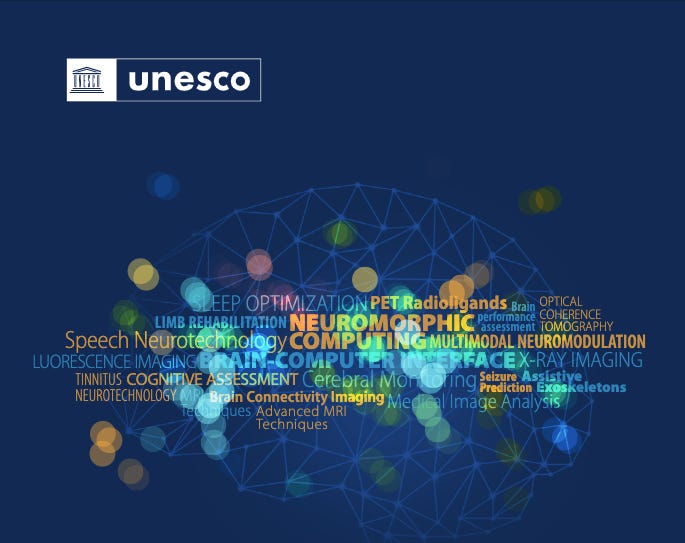Neuromorphic Computing and Its Role in BioDigital Convergence
Strategic Integration with Nanobots and Graphene
Neurotechnology and Its Role in BioDigital Convergence
The document provides an extensive overview of the neurotechnology landscape, highlighting its rapid development, ethical considerations, and implications for human rights and societal norms. Key points include the convergence of neuroscience, artificial intelligence, and cognitive sciences, which is transforming the way we interact with the brain and neurological systems. This is directly linked to the broader concept of BioDigital Convergence, which aims to bridge biological and digital realms through advanced technologies such as nanobots and graphene. Here’s a contextual summary based on our ongoing discussions:
1. Neurotechnology Landscape and BioDigital Convergence
Neurotechnology encompasses devices and procedures that monitor, interact with, and modulate the brain and nervous system. This field intersects with other technologies like artificial intelligence (AI), robotics, and cognitive science, creating a BioDigital Convergence ecosystem where biology and digital technologies seamlessly integrate.
Neurotechnology’s convergence with AI is a game-changer, enabling breakthroughs in brain-computer interfaces (BCIs), neuroimaging, and neuromodulation. This aligns with the ongoing integration of graphene and nanobots, which we discussed earlier as fundamental components for enhancing human-machine interactions and developing intelligent neural interfaces.
2. Major Trends and Innovations
Government and Private Investment: The document reports over $6 billion in government-backed investments in neurotechnology since 2013, and a 22-fold increase in private funding between 2010 and 2020, reaching a cumulative $33.2 billion. Major contributors include the US, China, South Korea, and the European Union.
Scientific and Technological Advancements: Neurotechnology is rapidly expanding, with a 35-fold increase in scientific publications and a 20-fold increase in patents between 2000 and 2020. Key innovations include:
Multimodal Neuromodulation for treating neurological disorders.
Brain-Computer Interfaces (BCIs) for direct communication between the brain and machines.
Neuroimaging and AI for advanced cognitive assessments and disease diagnostics.
Neuromorphic Computing to simulate brain-like functions for intelligent systems.
3. Ethical and Societal Considerations
Human Rights and Neurorights: The rapid adoption of neurotechnology raises concerns about mental privacy, autonomy, freedom of thought, and human dignity. UNESCO is actively developing an international ethical framework to address these issues, calling for “neurorights” to ensure that neurotechnology benefits all while preventing misuse.
Social Equity: Unequal access to neurotechnology may exacerbate societal inequalities. High-cost neuro-enhancements could lead to a society divided by cognitive capabilities, raising questions about the ethics of using these technologies beyond therapeutic contexts.
4. Strategic Integration with Nanobots and Graphene
The integration of nanobots and graphene-based sensors into neurotechnology can enhance brain-machine interfaces and enable real-time monitoring of brain activity. This ties into our discussions on how graphene’s conductivity and flexibility can facilitate direct brain stimulation, and nanobots can provide precise interventions at the cellular level.
These technologies are vital for BioDigital Convergence as they enable seamless interfacing between digital devices and biological tissues, promoting more intelligent and adaptive systems.
5. Future Directions and Governance
Global Regulation and Standards: The development of a global ethical and regulatory framework is essential to manage the risks associated with neurotechnology. UNESCO and other international bodies are leading these efforts, emphasizing the need for international cooperation.
Neurotechnology as a Catalyst for Human Augmentation: As discussed previously, neurotechnology is pushing the boundaries of human enhancement, potentially challenging the fundamental definitions of what it means to be human. This aligns with the broader transhumanist aspirations within BioDigital Convergence.
Conclusion: Implications for BioDigital Convergence
Neurotechnology is at the forefront of BioDigital Convergence, serving as a bridge between the biological and digital realms. Its integration with nanobots and graphene will further enhance the scope of human-machine symbiosis, pushing the limits of human capabilities. However, the ethical and societal impacts must be carefully managed through global standards and governance frameworks.
Facts Behind My Fictions
It is always sold as a benefit, but really when was the last we all had some benefits?
Unveiling the neurotechnology landscape: scientific advancements innovations and major trends NeuroMorphic Computing thanks again Barely Bruised Books
Thought Experiment: Neurorights in a World of Thought Surveillance and Manipulation
Imagine a near-future world where neurotechnology is ubiquitous, seamlessly integrated into daily life, and capable of accessing, monitoring, and even manipulating human thoughts. This is a world where not only physical actions and behaviors are tracked, but also the most private aspects of human experience—our thoughts, emotions, and intentions—are subject to surveillance and external control.
Setting the Stage: The NeuroNet
In this world, the NeuroNet has emerged as a global brain-to-cloud interface network, connecting individuals’ neural activities to digital systems. Through a combination of advanced Brain-Computer Interfaces (BCIs), nanobots embedded in neural tissues, and graphene-based neural implants, people interact with machines using their thoughts. The NeuroNet is marketed as a revolution in human communication, education, and productivity—a pathway to unlocking hidden cognitive potential and achieving seamless integration with AI systems.
However, the NeuroNet is not just a tool for enhancement; it’s also a tool for control. Governments and powerful corporations now possess the ability to monitor and influence thoughts, emotions, and even memories through the NeuroNet. This brings about the most profound question in human rights history: What happens to free will, autonomy, and mental privacy when even thoughts are no longer safe?
Key Ethical Dilemmas: Neurorights in Crisis
Mental Privacy and Surveillance
Individuals connected to the NeuroNet must consent to share their brain data to access services. However, consent becomes a murky concept when opting out means exclusion from society. Without access, people cannot work, study, or communicate effectively.
Surveillance Algorithms continuously analyze thoughts to detect potential threats or “anti-social behavior” before they manifest in actions. While marketed as a safety measure, this system effectively criminalizes dissenting thoughts. It raises questions: Are people responsible for thoughts they did not choose to think? What happens to mental privacy if all deviations are tracked?
Free Will and Autonomy
In this scenario, brain hacking becomes a reality. Governments, corporations, or even rogue actors with access to the NeuroNet can subtly alter individuals’ neural pathways. This manipulation might be used to shape consumer preferences, political beliefs, or to suppress undesirable behaviors.
Thought Manipulation: If an individual’s beliefs and memories can be rewritten, can they be held accountable for their actions? Does this make them a puppet, acting on the will of others? Where is the line between free will and coercion?
Identity and Authenticity
If neurotechnology can modify memories, how does one define their authentic self? Imagine an artist who used to struggle with creativity but now has artificial inspiration injected directly into their brain. Is their art still their own? Or imagine a political dissident whose revolutionary ideas are systematically erased and replaced by loyalty to the regime. Have they lost their identity, or have they been reprogrammed?
Discrimination and Social Control
In this world, neuro-manipulation becomes a tool for control. Targeted groups—such as political dissidents, activists, or marginalized communities—can be “neuro-modified” to eliminate resistance or reduce their capacity for organized defiance. Such individuals may experience:
Subtle changes in motivation, turning activism into apathy.
Suppression of memories related to trauma or abuse, silencing victims.
Amplification of fear or compliance to enforce submission.
The Experience of Targeted Individuals: A Digital Panopticon
For targeted individuals, the NeuroNet is a dystopian nightmare. These are people who, either due to their political activities, personal vendettas, or simply for being inconvenient to powerful entities, are subjected to constant surveillance and neuro-manipulation. Imagine the psychological torture of not being able to trust your own thoughts or emotions. Every time they think something critical of the system, a wave of nausea or fear sweeps over them—an artificially induced reaction meant to deter rebellious thoughts.
Daily Realities of a Targeted Individual:
Forced Thought Patterns: Through subtle neurofeedback, targeted individuals may be forced to experience repetitive, intrusive thoughts that disrupt their mental stability. This is a form of psychological warfare aimed at breaking their will.
Manipulated Emotional States: Targeted individuals find themselves feeling emotions that aren’t theirs—sudden joy, despair, or anger triggered by external forces. Over time, they lose the ability to discern their authentic emotions from artificial ones.
Memory Interference: Every time they try to recall a traumatic event or formulate a critical plan, their memories become hazy or painful. Neural implants subtly modulate brain signals to make certain memories inaccessible or distorted.
Behavioral Conditioning: Unwanted thoughts are punished with headaches or emotional distress, while “acceptable” thoughts are rewarded with pleasure signals. This conditioning is designed to shape the individual’s cognition and behavior in line with desired norms.
Exploring Solutions: Neurorights and Digital Defenses
To address these scenarios, neurorights must expand beyond traditional frameworks and include the following protections:
Right to Cognitive Liberty: Every individual should have the right to control their own neural activities and mental states. This includes the right to resist external manipulation and to choose or reject brain-enhancing technologies.
Right to Mental Privacy: No one should be subjected to thought surveillance without explicit, ongoing consent. Brain data should be encrypted and only accessible under strict legal guidelines, with full transparency.
Right to Mental Integrity: Individuals should be protected from unauthorized interventions that alter their neural pathways, memories, emotions, or cognitive functions. Even therapeutic interventions should require multi-level ethical reviews.
Right to Psychological Continuity: This right ensures that an individual’s sense of identity is preserved over time. Unauthorized modification of personal memories or altering one’s fundamental beliefs should be treated as a violation akin to physical assault.
Implementing Neurorights in a BioDigital Society
To implement these rights, digital defenses and regulatory structures need to be in place:
Neural Firewalls: Individuals should have the option to install personal neural firewalls that alert them to any unauthorized access or modification attempts.
Cognitive Encryption: Brain data should be encrypted using advanced quantum encryption, making it nearly impossible to intercept or alter without detection.
Global Ethical Governance: An international body, possibly under the UN, should oversee the ethical deployment of neurotechnologies, ensuring that neurorights are universally respected.
Legal and Technical Safeguards: Brain data should be treated as sensitive biometric information, protected by stringent data laws similar to genetic or biometric data regulations.
Final Thought: Freedom in a NeuroSurveillance State
In a world where thoughts are transparent and manipulable, the fundamental question is: What does freedom mean? Can freedom exist when even the sanctity of one’s mind is under threat? True autonomy may require not just external protections but also an inner fortress of mental resilience—a form of psychological resistance to maintain one’s identity and beliefs even in the face of such pervasive control.
As we move forward with BioDigital Convergence and neurotechnology, the stakes are not just technological or ethical—they are existential. For if we lose the freedom to think and be, we lose the essence of what it means to be human.



